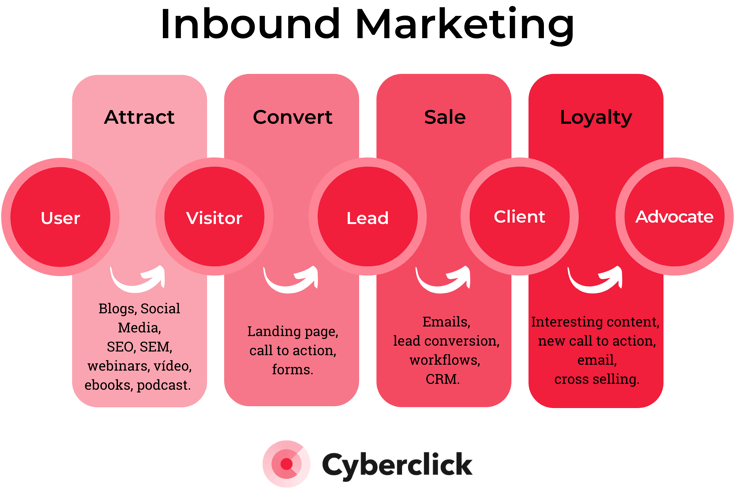If you work in marketing, you know that Inbound marketing and SEO (search engine optimization) can help you boost your business and grow your brand.
But you may be wondering: is one better than the other?
And more importantly: can both areas of expertise work together to make the biggest impact?
That is exactly what we will answer in this article about SEO and inbound marketing. It is broken down into the following sections, so it’s easy for you to find the information you’re looking for:
What is Inbound Marketing?
Inbound marketing is a method of attracting customers by creating content that is valuable and tailored to them.
The point is to generate opportunities without having to interrupt the user.
Broken down simply, inbound marketing has four stages. These include the following:
- Attract visitors to your website with content that helps them get answers to questions they have as they do their own research.
- Convert them to leads while they look into their problems by going through your content to find out more information.
- Capitalize on the trust you form with the customer by supporting them and their decision-making process.
- Convert the new customers into advocates who promote your brand.
There are different kinds of inbound marketing content that you might use.
Some common forms of inbound marketing content include newsletters, webinars, social media marketing, eBooks, podcasts, and others.
What is SEO?
SEO is an abbreviation that stands for search engine optimization.
This is an important practice that increases the quality and quantity of the traffic that comes to your website by making your content easier to find by those searching for it.
Search engine optimization includes several steps, such as:
- Performing keyword research to see what people are searching for.
- Adjusting and aligning your website’s keywords to match those topics.
- Using keywords to optimize each page of your website.
- Focusing on creating content that is also optimized for the chosen keywords.
- Adapting, improving, and monitoring the website to see how its performance changes over time.
While there are different methods of using SEO to get visitors to your website, the goal is to create structured content that generates quality leads and opportunities.
You want to know that the content you create is reaching the right people, and to do this, you need to be sure that Google’s algorithm is identifying the purpose of your content and suggesting it to the correct users.
What Does SERP Have to Do With SEO?
SERP stands for search engine results page. You want to rank as highly as you can on SERPs, because the higher you rank, the more traffic your website is likely to get.
Search engine results pages are the pages that come up when someone enters a search into Google or another search engine.
For example, if you type, “Pandas,” you may receive back several websites that contain information about the Python Data Analysis Library, the animal or, in some cases, PANDAS, the medical condition.
What determines the websites that come up? Largely, the websites’ SEO techniques.
Pages with excellent keyword optimization and good content are likely to rank higher, reaching more users. However, pages are also suggested based on the user’s browsing history, social settings, and physical location.
It is possible to have two SERPs that look identical, but that have some variations in results.
For the example above, for instance, someone researching panda bears may receive more content with the animal than a medical provider doing research on PANDAS. Why? Google and other search engines attempt to tailor the results to their users.
You can expect search engine result pages to be in a state of constant flux as Bing, Google, and other search engine providers tweak their algorithms. Their goal is to provide the content that their users want, so they have a more intuitive experience.
For you, that means that your SEO needs to be concise.
It should be optimized to include keywords that show the intention of your content. Multiple keyword strings and combinations can be used to maximize visibility and to be sure your website shows up in front of the correct users.
What’s the Difference Between Organic and Paid Results?
SERPs usually have both paid and organic results. Organic results are what you’re aiming for. These are results that come up as a result of search engine optimization.
Paid results show up because an advertiser has paid Google or another search engine provider to post them. These, in the past, usually showed up as text-based ads.
Today, they come in many forms and can include links that look like any other search results.
Do You Need to Use SEO?
If you want your website to be seen, SEO is crucial. SEO is what makes your website visible. It’s what draws traffic to your website and makes sure users are hitting your landing page.
Good SEO creates more opportunities for you. With the right SEO in place, you have the opportunity to convert hundreds, if not thousands or more people, to customers of your business.
If you choose not to use SEO, you will likely see a drop in search rankings and results.
Your average daily or monthly visitor count will likely decrease, and your website will have less visibility online. Fortunately, you can implement SEO at any time in order to begin increasing your visibility again.
Inbound Marketing and SEO: The Differences Explained
There are some overlapping elements of inbound marketing and SEO.
Put simply, inbound marketing generates leads through the content on your website, and SEO helps boost that strategy by making sure that content gets in front of the correct user when they’re looking for it.
SEO is, technically, an aspect of inbound marketing.
It’s important to have an SEO-optimized website, because having the right keywords and content to draw in customers matters.
However, without inbound marketing, the customers may come to the website and bounce without making a purchase or looking deeper. That’s where inbound marketing comes in.
Inbound marketing strategies build on the visibility of the website and take steps to encourage conversions.
In inbound marketing strategies, SEO is usually part of the first stage, which is to attract the customer.
From there, the rest of the strategy focuses on converting the customer, making a sale, and encouraging loyalty through cross-selling, interesting content, new calls to action, or other techniques.
How Can SEO and Inbound Marketing Work Together?
Think about SEO as a function of a much larger inbound marketing process.
The first stage of inbound marketing generally uses SEO to get content in front of users.
Blogs, social media posts, SEM, podcasts, and other content are optimized with keywords to make sure that when a user searches for the topic, your website comes up.
There are multiple tactics that you could use to achieve a top position in search engine results pages (SERPs). Some include:
- Creating optimized URLs.
- Optimizing your website’s SEO.
- Content marketing.
- Link building between your site and other high-ranking websites.
- Creating interesting titles, descriptions and headlines.
- Keyword research.
- Keyword selection.
Good SEO brings in visitors, but SEO doesn’t necessarily convert those leads into sales or repeat customers.
Inbound marketing has to move forward and work to convert the sale with forms that potential customers fill out, landing pages with interesting information, or calls-to-action.
Making a sale, the third step of inbound marketing, requires lead conversion. This could happen with repeat emails or different types of workflows that lead the customer to interact with your business in the way you want.
Finally, after a purchase or once the user has completed a task the way you want, you focus on loyalty.
Continuing to post optimized content, interesting updates, or cross-selling can all be good techniques to encourage loyalty to your brand.
Regular newsletters, emails, calls, texts, and other content could also boost customer retention and even encourage them to advocate for your brand.

Wrap Up
Using inbound marketing and SEO together is a good way to improve the number of visits to a website and encourage users to make a purchase or interact with the website during that visit.
Inbound marketing also includes follow-up tactics to encourage loyalty to your brand.
At Rock Content, we want to help you make the most of your website and improve your brand recognition.
Do you want to learn more? Check out this article on the SEO trends of 2022 that can help you improve your page visibility and results.

![[WA] Ultimate Content Marketing Kit](https://rockcontent.com/wp-content/uploads/2022/08/Content-Marketing-Kit-750x200px.jpg)


![[ROCK NA] [EBOOK SEO] Complete Guide](https://rockcontent.com/wp-content/uploads/2024/06/banner_Search-Engine-Optimization.png)






